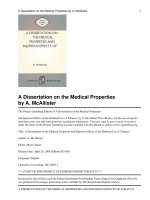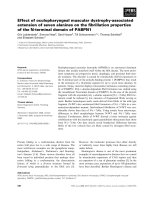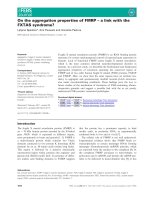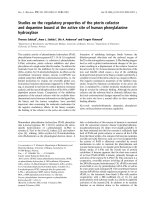Impact of adding chia seeds (Salvia hispanica) on the quality properties of camel burger “Camburger” during cold storage
Bạn đang xem bản rút gọn của tài liệu. Xem và tải ngay bản đầy đủ của tài liệu tại đây (311.1 KB, 8 trang )
Int.J.Curr.Microbiol.App.Sci (2018) 7(3): 1356-1363
International Journal of Current Microbiology and Applied Sciences
ISSN: 2319-7706 Volume 7 Number 03 (2018)
Journal homepage:
Original Research Article
/>
Impact of Adding Chia Seeds (Salvia hispanica) on the Quality Properties of
Camel Burger “Camburger” during Cold Storage
Engy F. Zaki*
Meat Production and Technology Unit, Animal Breeding Department, Desert Research
Center, Cairo, Egypt
*Corresponding author
ABSTRACT
Keywords
Chia seed, Camel
burger, TBA value,
Microbiological
quality
Article Info
Accepted:
12 February 2018
Available Online:
10 March 2018
This study aimed to investigate the effect of adding chia seeds (Salvia hispanica) in the
formulation of camel burger on the pH, TBA value, color measurements, microbiological
analysis and sensory evaluation during cold storage at 4° C for 12 days. Results indicated
that pH value of all camel burger samples slightly increased during the first 3 days of
storage. No significant differences were found in pH value of control and formulated
samples at any time of storage period. Addition of chia seeds showed significant effects on
TBA values of formulated camel burger compared to control samples during storage. All
burger samples significantly increased as the time of cold storage increased. Burger
formulated with 5 % chia seeds had the lower TBA value than other burger samples.
Significant differences were found in color measurements of control and formulated burger
during storage. Total bacterial count of all burger samples slightly decreased during 6 days
of cold storage whereas after day 6 there was gradual increase in all burger samples.
Burger formulated with 3 and 5% of chia seeds showed lower count of psychrotrophic
bacteria compared with control samples. Camel burger formulated with 3% chia seeds
recorded the higher score in sensory attributes.
Introduction
Although fat is an important component in
meat products, the demand for low fat meat
products formulated with healthier lipid
sources has greatly increased since high fat
intake, especially saturated fats, is associated
with obesity, cardiovascular and chronic
diseases (AHA, 1996). Since fat contributes
texture and flavor to meat products, reducing
fat content in formulation may alter product
quality; products with less fat content is
firmer, more rubbery, less juicy, darker in
color and more costly (Keeton, 1994). In order
to conquer these problems, fat replacers are
candidates to improve the texture and
sensorial properties of low-fat meat products.
Incorporation of some ingredients into foods
such as flax seed and chia seed, as well as in
oils rich in unsaturated fatty acids could be
used as fat replacer.
Chia (Salvia Hispanica L.) is an annual
herbaceous plant belonging to the Lamiaceae
or Labiatae family. Chia seed is composed of
protein
(15–25%),
fats
(30–33%),
1356
Int.J.Curr.Microbiol.App.Sci (2018) 7(3): 1356-1363
carbohydrates (26–41%), dietary fiber (18–
30%), and ash (4-5%), it also contains a high
amount of vitamins, minerals, dry matter (90–
93%) and antioxidants (Ali et al., 2012).
Chia seed contains between 30 - 33.5 g
oil/100g with high concentrations of
polyunsaturated fatty acids (PUFA), being αlinolenic acid (ALA), a n-3 fatty acid the main
essential fatty acid present in it 57 - 65 g/100g
(Ayerza, and Coates, 2011). In addition, it is
known that the chia seeds contain a great
amount of polyphenolic compounds with
potent antioxidant activity, mainly flavonoids
such as quercetin, kaempferol, myricetin and
others (Ixtaina et al., 2011).
Although CHIA is a potential ingredient in
health and diet food products on its
physicochemical properties, it is seldom used
in meat products (Marineli et al., 2015).
prepared as follows ingredients; 10% onion,
0.5%black pepper, spices0.5%, salt 1.5%.
Chia seeds were previously grinded. Camel
burgers were prepared according to the
following formulations:
Control: 20% fat 0 % chia seeds
Formula 1: 0% fat 1% chia seeds
Formula 2: 0% fat 3% chia seeds
Formula 3: 0 % fat 5% chia seeds
Batches of 2kg of each formula were handily
mixed and formed by using manual burger
press machine (1cm thickness, 10cm diameter
and 60±2g weight). Burgers were placed in
plastic foam meat trays, packed in
polyethylene bags and stored at 4 ±1oC for 12
days.
Physical analysis
pH value
Therefore, the aim of this study is to
investigate the effect of adding different levels
of chia seeds in the formulation of camel
burger on pH value, color measurements, lipid
oxidation, microbiological quality and sensory
evaluation during cold storage at 4°C for
12days.
Materials and Methods
pH value of raw camel burger samples was
determined as described by Hood(1980). Ten
grams of sample was homogenized with
100ml distilled water and measured using a
digital pH-meter Jenway 3310 conductivity
and pH meter. pH values were determined in
triplicate for each sample at 0, 3, 6, 9 and 12
days of storage at 4°C.
Preparation of camel burger (Camburger)
Color measurements
Camel meat and humped fat obtained from
local slaughter house were used in this study.
Left round (Biceps femoris) muscles of 3-4
years aged camel were pooled to form an
experiment unit, with three (batches) of lean
ground meat being prepared from each burger
formulation.
Color of raw camel burger samples was
measured by Chroma meter (Konica Minolta,
model CR 410, Japan) calibrated with a white
plate and light trap supplied by the
manufacturer (CIE, 1976).
All knives – separable fat was removed from
muscles and used with humped fat as fat
source. Lean meat was ground through a 3mm
plate grinder. Camel burger samples were
The color was expressed as L* (lightness), a*
(the redness), b* (the yellowness), C*
(saturation index) and h* (hue angle). The
average of three spectral readings at different
locations was obtained for each treatment
during storage periods.
1357
Int.J.Curr.Microbiol.App.Sci (2018) 7(3): 1356-1363
Determination of T.B.A value
Results and Discussion
Measurement of lipid oxidation: The extent of
lipid oxidation in raw camel burger was
assessed by measuring 2- thiobarbituric acid
reactive substances (TBARS), as described by
AOCS (1998).
pH value
TBARS values were determined in triplicate
for each sample at 0, 3, 6, 9 and 12 days of
storage at 4°C.
Microbiological analysis
The analyses of total bacterial count and
psychrotrophic bacteria at 0, 3, 6, 9 and 12
days of storage at 4°C were determined
according to Ercolini et al., (2009).
Sensory evaluation
Camel burger was subjected to organoleptic
evaluation as described by A. M. S. A. (1995).
Twenty trained panelists of staff members of
Food Science Department, Faculty of
Agriculture, Ain-Shams University were
scored appearance, texture, juiciness, flavor,
tenderness and overall acceptability using a 9point hedonic scale.
The samples of each treatment were cooked in
preheated oven at 180°C for 3 min each side
(internal temperature 70°C ±5). Samples were
coded, cut and served in white disposable
dishes.
Statistical analysis
All data generated from each treatment were
analyzed using statistical analysis system
(SAS, 2000).
Two- way ANOVA was applied for pH, TBA,
color measurements and microbiological
analyses. In case of sensory evaluation one –
way ANOVA was applied.
Data of pH value of camel burger formulated
with different levels of chia seeds during cold
storage are shown in Table 1. No significant
differences were found in pH value between
control and formulated samples at zero time.
The pH value of all camel burger samples
slightly increased during the first 3 days of
storage. However, no significant differences
were found in pH value of control and
formulated samples at any time of storage
period. These results are close to that obtained
by Scapin et al., (2015) they found that the pH
value of pork sausage treated with different
concentrations of chia seeds extract were not
significantly different between treatments
during 28 days of storage at 4°C.
T.B.A value
Results of TBA value of camel burger
formulated with chia seeds during storage at
4°C for 12 days are presented in Table 2. As
can be seen, there was a significant increase in
TBA values of control samples during storage
period. Addition of chia seeds showed
significant effects on TBA values of camel
burger compared to control samples during
storage.
All
camel
burger
samples
significantly increased as the time of cold
storage increased. However, at any time of
cold storage, burger formulated with 5 % chia
seeds had the lower TBA value than other
burger samples. These results are close to that
obtained by Scapin et al., (2015) they found
that a significant increase in TBA value for all
pork sausage (control and treated with chia
extract) during cold storage at 4°C for 28
days. Also, Melo et al., (2015) found that
TBARS increased in all hamburger samples
(control and treated with chia seeds extract)
during frozen storage at -18°C for 120 days.
Riernersman et al., (2016) reported that
1358
Int.J.Curr.Microbiol.App.Sci (2018) 7(3): 1356-1363
TBARS values of formulated burger was
considerably lower than the control for each
sampling during storage, indicating high
protection of whole chia flour against lipid
oxidation in cooked fish burger. This
antioxidant effect of chia on the formation of
TBARS can be due to the presence of
polyphenolic compounds with antiradical
activity and reducing power before determined
(Ixtaina et al., 2011).
Color measurements
Color measurements of camel burger
formulated with different levels of chia seeds
during cold storage at 4°C for 12 days are
given in Table (3). Fresh control sample
showed higher L* value while, no significant
differences were found between formulated
samples. As can be seen, L* value was
significantly increased in control samples
during cold storage. While, burger treated with
1 and 5% chia seeds showed significant higher
in L* value after 6 days of storage and no
significant differences were found after 9, and
12 days. However, addition of chia seeds had
no significant effect on L* value during
storage. These results are close to that
obtained by Mokhtar et al. (2014) they
reported that slight increased was found in L*
value of beef patties after 6 days of storage
and no significant differences were found after
12 and 15 days of storage at 4°C. From the
same table, it can be found that fresh control
sample had the higher a* value and no
significant differences were between other
formulated burger.
These results are
consistent with Scapin et al. (2015) they
reported that there was significant difference
(p < 0.05) between the control and the other
treatments; the control showed higher results.
During cold storage, a* value were
significantly decreased in all burger samples.
These results are agreed with Mokhtar et al.
(2014). However, addition of 1 and 3% chia
seeds significantly improved the color stability
and retention of red color in camel burger
during cold storage for 12 days at 4°C.
The b* values of control and formulated
burger during cold storage were presented in
Table 3. Fresh control sample had the higher
b* value followed by burger formulated with
5% chia seeds. No significant differences were
found between camel burger formulated with
1 and 3% chia seeds. During cold storage
significant increase were found in all camel
burger samples.
Results of C* value of camel burger indicated
that fresh control burger had the higher C*
value and no significant differences were
found in camel burger formulated with
different levels of chia seeds. Also, it can be
found that all burger samples trend to decrease
as the time of cold storage increased. The h*
values of camel burger were significantly
increased as the time of cold storage
increased. Scapin et al., (2015) found that on
the 1st, 7th and 28th days of storage there was
significant difference (p < 0.05) between
control and the other treatments, where the
control samples showed higher results than the
other treatments.
Microbiological analysis
Total bacterial count and psychrotrophic
bacteria of camel burger formulated with
different levels of chia seeds were shown in
Table 4. No significant differences were found
in total bacterial count of fresh control and
formulated burger. Total bacterial count of all
burger samples slightly decreased during 6
days of cold storage whereas after day 6 there
was gradual increase in all burger samples. No
significant differences were found in total
bacterial count between control and treated
samples during 6 days of storage but
significant decrease was found in burgers
formulated with chia during 9 and 12 days of
storage.
1359
Int.J.Curr.Microbiol.App.Sci (2018) 7(3): 1356-1363
Table.1 pH value of camel burger formulated with different levels of chia seeds during storage at
4°C for 12 days
Storage periods (days)
Treatments
0
3
6
9
12
SEM
pH
Control
1% Chia seeds
3% Chia seeds
5% Chia seeds
5.48±0.39Ab
5.45±0.22Aa
5.60±0.01Aa
5.62±0.05Aab
5.79±0.04Aa
5.68±0.12Aa
5.74±0.02Aa
5.80±0.04Aa
5.53±0.02Ab
5.58±0.04Aa
5.56±0.04Aa
5.50±0.02Ab
5.58±0.04Aab
5.61±0.01Aa
5.60±0.05Aa
5.54±0.03Ab
5.47±0.08Ab
5.60±0.04Aa
5.57±0.08Aa
5.41±0.03Ab
0.06
0.06
0.06
0.06
a-b
means within the same row with different superscripts letters are different (p<0.05).
means within the same column with different superscripts letters are different (p<0.05).
Means ± standard deviation. SEM: standard error of means.
A
Table.2 TBA value of camel burger formulated with different levels of chia seeds during storage
at 4°C for 12 days
Storage periods (days)
Treatments
0
3
0.38±0.008Bd
0.15±0.003Ce
0.15±0.001Cd
0.60±0.005Ab
0.01
Control
1% Chia seeds
3% Chia seeds
5% Chia seeds
SEM
0.50±0.001Ac
0.23±0.001Bd
0.17±0.001Cd
0.17±0.001Cd
0.01
6
T.B.A value (mgMDA/kg)
1.12±0.005Ab
0.50±0.004Bc
0.33±0.003Cc
0.31±0.001Cc
0.01
9
12
1.15±0.007Ab
0.88±0.001Bb
0.80±0.003Bb
0.66±0.005Cb
0.01
1.19±0.01Aa
0.95±0.001Ba
0.90±0.002BCa
0.87±0.11Ca
0.01
a-e
means within the same row with different superscripts letters are different (p<0.05).
means within the same column with different superscripts letters are different (p<0.05).
Means ± standard deviation. SEM: standard error of means.
A-C
Table.3 Color measurements of camel burger formulated with different levels of chia seeds
during storage at 4°C for 12 days
Storage periods (days)
Treatments
0
3
6
9
12
Aab
Aa
SEM
L*
Control
1%Chia seeds
3% Chia seeds
5% Chia seeds
Ab
36.69±0.21
30.31±0.06Bb
30.85±0.18Ba
31.08±0.15Bb
Ab
Aa
36.52±0.13
30.31±0.03Bb
30.43±0.12Ba
31.19±0.15Bb
38.32±1.02
33.47±1.24Ba
30.02±0.47Db
32.40±0.18Ca
Control
1% Chia seeds
3% Chia seeds
5% Chia seeds
15.57±0.10Aa
11.17±0.04Ba
11.64±0.08Ba
10.99±0.15Ba
14.30±0.06Ab
10.75±0.11Ba
10.20±0.19Bb
8.61±0.09Cb
9.97±1.13Ad
9.13±0.93ABb
8.42±0.04Bc
7.68±0.20Bc
Control
1% Chia seeds
3% Chia seeds
5% Chia seeds
8.78±0.04Ac
5.15±0.02Cd
5.77±0.06Cb
6.07±0.02Bb
9.81±0.03Aa
5.75±0.06Cc
6.41±0.03Ba
6.15±0.08Bb
7.93±0.55Ad
6.82±0.47Ba
5.66±0.21Cb
6.57±0.08Ba
Control
1% Chia seeds
3% Chia seeds
5% Chia seeds
17.88±0.10Aa
12.30±0.04Ba
12.99±0.10Ba
12.56±0.13Ba
17.35±0.06Aa
12.19±0.13Ba
12.05±0.17Bb
10.59±0.12Cb
13.51±1.10Ac
11.40±1.01Bb
10.14±0.11Cc
9.95±0.46Cb
Control
1% Chia seeds
3% Chia seeds
5% Chia seeds
29.43±0.12Ad
24.77±0.07Ce
26.39±0.08Be
28.92±0.29Ae
34.52±0.10Ac
28.15±0.11Cd
32.15±0.39Bd
35.55±0.15Ad
37.75±0.87Bb
36.85±1.39Bb
33.91±1.08Cc
40.53±0.41Ac
37.17±0.28
30.86±0.25Bb
30.56±0.11Ba
31.09±0.07Bb
37.94±0.12
30.82±0.14Bb
30.95±0.09Ba
30.67±0.05Bb
0.23
0.23
0.23
0.23
12.07±0.10Ac
8.52±0.21Bb
8.03±0.13Bc
6.26±0.06Cd
7.13±0.06Ae
5.97±0.07Bc
6.03±0.02Bd
5.13±0.02Ce
0.20
0.20
0.20
0.20
9.46±0.09Aab
5.95±0.07Cc
6.19±0.05BCa
6.46±0.02Bb
9.97±0.05Aa
6.26±0.01Bab
6.22±0.05Ba
6.21±0.01Bb
0.10
0.10
0.10
0.10
15.34±0.14Ab
10.39±0.21Bc
10.14±0.13Bc
8.99±0.05Cbc
12.26±0.08Ad
8.64±0.06Bd
8.66±0.05Bd
8.05±0.01Bc
0.21
0.21
0.21
0.21
38.09±0.02Bb
34.95±0.51Cc
37.59±0.32Bb
45.91±0.21Ab
54.40±0.07Aa
46.33±0.28Ca
45.88±0.23Ca
50.43±0.17Ba
0.28
0.28
0.28
0.28
a*
b*
C*
h*
a-e
means within the same row with different superscripts letters are different (p<0.05). A-C means within the same column with
different superscripts letters are different (p<0.05). Means ± standard deviation. SEM: standard error of means.
1360
Int.J.Curr.Microbiol.App.Sci (2018) 7(3): 1356-1363
Table.4 Total bacterial count and psychrotrophic bacteria count of camel burger formulated with
different levels of chia seeds during storage at 4°C for 12 days
Treatments
0
Control
1% Chia seeds
3% Chia seeds
5% Chia seeds
6.11±0.07Ab
6.30±0.09Ab
6.67±0.11Aa
6.67±0.19Ab
Control
1% Chia seeds
3% Chia seeds
5% Chia seeds
6.44±0.06Ac
6.30±0.04Ab
6.32±0.08Aa
6.71±0.01Aa
Storage periods (days)
3
6
9
Total bacterial count (Log CFU/g)
6.41±0.05Ab
5.54±0.20Ab 7.84±0.06Aa
6.25±0.05Ab
5.70±0.04Ab 6.56±0.01Bb
Aa
6.88±0.07
5.57±0.18Aa
6.17±0.06Ba
6.82±0.14Ab
6.14±0.06Ab 6.56±0.19Bb
Psychrotrophic bacteria (Log CFU/g)
4.96 ±0.24Ad
5.34±0.06Acd 7.39±0.09Aa
3.90±0.05Ab
5.15±0.03Ab 6.42±0.12Cb
Ab
4.59±0.11
5.95±0.03Aa
6.40±0.05Ca
4.78±0.04Ac
5.90±0.02Ac
6.91±0.05Ba
12
SEM
7.91±0.01Aa
7.74±0.09Ba
6.47±0.07Ca
7.67±0.19Ba
0.33
0.33
0.33
0.33
7.14±0.09Ab
7.13±0.13Aa
6.62±0.06Ba
6.16±0.15Bb
0. 93
0. 93
0. 93
0. 93
a-c
means within the same row with different superscripts letters are different (p<0.05).
means within the same column with different superscripts letters are different (p<0.05).
Means ± standard deviation. SEM: standard error of means.
A-C
Table.5 Sensory evaluation of camel burger formulated with different levels of chia seeds
Treatments
Appearance
Texture
Juiciness
Flavor
Tenderness
Control
1% Chia seeds
3% Chia seeds
5% Chia seeds
SEM
7.5±0.52bc
7.8±0.74b
8.90±0.21a
7.33±0.49c
0.13
7.53±0.52cb
7.86±0.35b
8.93±0.18a
6.80±0.56d
0.10
7.26±0.46c
7.86±0.74b
9.00±0.04a
7.00±0.53c
0.11
7.80±0.41b
7.86±0.35b
8.95±0.11a
6.80±0.41c
0.08
7.26±0.46c
7.66±0.49b
8.80±0.19a
8.00±0.85b
0.13
Overall
acceptability
7.40±0.51bc
7.73±0.46b
9.00±0.53a
7.06±0.80c
0.13
a-c
means within the same column with different superscripts letters are different (p<0.05).
Means ± standard deviation. SEM: standard error of means.
These results are coincided with Scapin et al.,
(2015) they reported that no significant
difference was found in control or treated
pork sausage with chia seeds extract on 1st and
14th of cold storage at 4°C.
Also, Ibrahim et al.,(2010) reported that
remarkable increase was found in aerobic
plate count throughout cold storage especially
in control patties at 6 and 9th days.
In general, significant decrease was found for
all treated patty compare with control sample
during storage period (3-9 days).
No significant differences were found in
psychrotrophic bacteria of camel burger
samples at zero time. All camel burger
significantly decreased after 3 and 6 days of
storage and increased again during 9 and
12days of storage period. However, burger
formulated with 3 and 5% of chia seeds
showed lower count of psychrotrophic
bacteria compared with control samples.
These results disagree with Scapin et al.,
(2015) they reported that the psychrotrophic
count varied between control and treated pork
sausage with chia extract over all the period
of cold storage. Also, they found that on the
1361
Int.J.Curr.Microbiol.App.Sci (2018) 7(3): 1356-1363
7th and 28th days of storage sausage treated
with highest concentration of chia 2% had the
higher count of psychrotrophic bacteria than
the other samples. Maqsood et al., (2015)
reported that natural phenolic compounds had
significant effect on microbial quality of
ground camel meat during refrigerator storage
for 9 days. Among all the samples, control
had higher psychrophilic bacterial count,
followed by samples treated with natural
phenolic compounds at day 9 of storage.
Sensory evaluation
Sensory evaluation of camel burger
formulated with different levels of chia seeds
are shown in Table 5. As can be seen camel
burger formulated with 3% chia seeds
recorded higher score in sensory attributes
compared with control burger. Also, it can be
found that burger formulated with 5% chia
seeds showed lower score for all sensory
attributes. No significant differences were
found between control and burger formulated
with 1% chia seeds. These results are close to
that obtained by Scapin et al., (2015) they
found that there was no significant difference
sensory attributes between the control sausage
and the sausage with added extract of chia
seed. In general terms, the pork sausages
containing 2% chia seed extract showed the
best results compared to the other
concentrations.
The results of the current study indicated that
addition of chia seeds in the formulation of
camel burger significantly decreased the lipid
oxidation during cold storage. However,
addition of 1 and 3% chia seeds significantly
improved the color stability and retention of
red color in camel burger during cold storage
for 12 days at 4°C. Camel burger formulated
with 3% chia seeds recorded higher score in
sensory attributes compared with control
burger.
Camel
burger
“camburger”
formulated with chia seeds can be
recommended as healthier low fat meat
products.
Further studies on the effects of adding chia
seeds on the quality characteristics of meat
products are suggested.
References
A.M.S.A. 1995. American Meat Science
Association. Research guidelines for
Cookery, Sensory Evaluation and
Instrumental Tenderness Measurements
of Fresh Beef. Chicago, IL, USA.
AHA. 1996. Dietary Guidelines for Healthy
American Adults.94, 1795-1800.
Ali, N. M., Yeap, S. W., Ho, W. Y., Beh, B.
K., Tan, S. W. and Tan, S. G. 2012. The
promising future of chia, Salvia
hispanica L. Journal of Biomedicine and
Biotechnology. Volume 2012, Article ID
171956, 9 pages.
AOCS. 1998. American Oil Chemists'
Society. Official method Cd 19-90. 2Thiobarbituric acid value. Direct
method. In: Firestone D, editor. Official
Methods and Recommended Practices of
the American Oil Chemists' Society, 5th
ed. Champaign, p.3.
Ayerza, R., and Coates, W. 2011. Protein
content, oil content and fatty acid
profiles as potential criteria to determine
the origin of commercially Grown Chia
(Salvia hispanica L.). Industrial Crops
and Products. 34, 1366-1371.
CIE. 1976. Commission International de L´
Eclairage.. Official recommendations on
uniform
colour
spaces.
Colour
difference equations and metric colour
terms, Suppl. No. 2. CIE Publication No.
15 Colourimetry. Paris.
Ercolini, D., Russo, F., Nasi, A., Ferranti, P.,
and Villani, F. 2009. Mesophilic and
Psychrotrophic Bacteria from Meat and
Their Spoilage Potential In Vitro and in
1362
Int.J.Curr.Microbiol.App.Sci (2018) 7(3): 1356-1363
Beef. Applied and environmental
microbiology. 75(7): 1990–2001.
Hood, D. E. 1980. Factors affecting the rate
of metmyoglobin accumulation in
prepackaged beef. Meat Science. 4 (4):
47–50.
Ibrahim, H.M., Abou Arab, A.A., and Abu
Salem, F.M. 2010. Addition of some
natural plants extracts and their effects
on lamb patties quality. Journal of Food
Technology. 8(3): 134-142.
Ixtaina, V. Y., Martínez, M. L., Spotorno, V.,
Mateo, C. M., Maestri, D. M., and
Diehl, B. W. K. 2011. Characterization
of chia seed oils obtained by pressing
and solvent extraction. Journal of Food
Composition Analysis. 24 (2): 166- 174.
Keeton, J. T. 1994. Low-fat meat products,
technological problems with processing.
Meat Sci. 36, 261-276.
Maqsood, S. Abushelaibi, A. Manheem, K.
Al Rashedi, A. Kadim, I. T.
2015.
Lipid oxidation, protein degradation,
microbial and sensorial quality of camel
meat as influenced by phenolic
compounds. LWT - Food Science and
Technology. 63, 953-959.
Marineli, R. D. S., Lenquiste, S. A., Moraes,
E. A., and Marostica, M. R. 2015.
Antioxidant potential of dietary chia
seed and oil (Salvia hispanica L.) in
diet-induced obese rats. Food Res Int.76
(3): 666-674.
Melo, J. M., Melo, R. N., Sicheski, S. J.,
Daniel, B. I., Perissinotto, A., Janeczko,
M. U. ,
Detofol, M.R., Alvarado
Soares, M. B., and Cansian, R. L. 2015.
Elaboration and evaluation of produced
hamburger with meat of old sheep and
pig with added of chia seed (Salvia
hispanica). International Journal of
Nutrition and Food Sciences. 4(1): 1418.
Mokhtar, S. M., Youssef, K. M., and Morsy,
N. E. 2014. The effects of natural
antioxidants on colour, lipid stability
and sensory evaluation of fresh beef
patties stored at 4ºC. Journal of
Agroalimentary
Processes
and
Technologies. 20 (3), 282-292.
Riernersman, C. N., María, R.A., Marina, D.
M., and Alicia, J. M. 2016. Whole Chia
Flour as Yield Enhancer, Potential
Antioxidant and Input of n-3 Fatty Acid
in a Meat Product. Food and Nutrition
Sciences. 7, 855-865.
SAS .2000. User’s Guide Statistics. SAS
Institute, Inc. Cary, N.C., USA.
Scapin, G., Schimdt, M. M., Prestes, R. C.,
Ferreira, S., Silva, A. F. C. and da Rosa,
C. S. 2015. Effect of extract of chia seed
(Salvia hispanica) as an antioxidant in
fresh pork sausage. International Food
Research Journal. 22(3): 1195-1202.
How to cite this article:
Engy F. Zaki. 2018. Impact of Adding Chia Seeds (Salvia hispanica) on the Quality Properties
of Camel Burger “Camburger” during Cold Storage. Int.J.Curr.Microbiol.App.Sci. 7(03): 13561363. doi: />
1363









